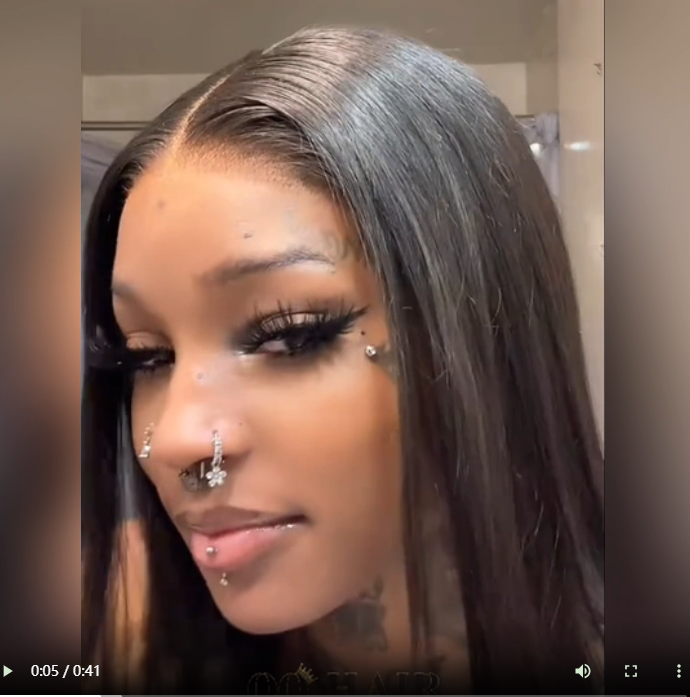Is It Bad To Submerge Wigs In Water To Wash
For wig enthusiasts and users, cleaning them is not only to keep the wigs tidy, but also to maintain perfect condition and extend their service life. A regularly cleaned wig will not only look more natural and smooth, but it will also maintain a soft feel and avoid tangles. However, for some beginners, when cleaning wigs, may wonder whether they can completely soak the wig in water like washing real hair. After all, when we usually wash our hair, our hair is usually completely wet. In this article, we will explore the effects of soaking wigs in water, analyze whether different wig materials are suitable for this cleaning method, and provide some safer and more effective wig cleaning suggestions.

A: In fact, it depends on the frequency of wearing and the environment. Of course, under certain circumstances, human hair should be cleaned a little more often than synthetic fiber wigs. Even high-quality fiber wigs are not as durable as human hair wigs. After a period of use, they are prone to knotting, frizziness, deformation and other problems, and have a shorter service life. So it is best to reduce the frequency of cleaning. Human hair wigs need to be cleaned and cared for regularly to maintain their natural softness and glossiness. Regular cleaning can remove residues on the hair and prevent the hair from becoming dry, frizzy or losing its luster. Synthetic fiber wigs are made of chemical materials and are not easy to absorb dust, grease or deform, so they do not need such frequent care.
If you wear a wig every day, then washing a human hair wig every two to three weeks is a more appropriate frequency (synthetic wig once a month), which can effectively remove accumulated grease, dust and hair care product residues. If the wig is not worn every day, but occasionally, it is enough to clean the human hair wig once a month (synthetic wig once every two months). In addition, if you wear a wig in a hot or humid environment and sweat a lot, you can increase the frequency of cleaning appropriately to keep the wig fresh and clean.
Q2: How to Dry A Wig?
A: No matter what type of wig it is, it is best to use the air-drying method. Synthetic wigs cannot withstand high temperatures, so never use a hair dryer to dry them. Human hair wigs can withstand high heat for secondary styling and can also be dried with a hair dryer. But try to minimize the number of times you use heat. Because it is made of real human hair, it has the same natural luster as real hair and is also as easy to dry out as real hair due to high temperatures. Of course, if the weather where you live is humid, it is still necessary to use a hair dryer. Remember to use heat-protectant spray to protect it before use.
Q3: How to Wash Your Wig Properly
A:1-Human Hair Wig
First, comb your wig with a wide-tooth comb. Be sure to start from the ends and gently comb to the roots to prevent tangles when washing. Next, fill a basin or sink with cold or warm water. Then, add a small amount of mild sulfate-free shampoo to the water and stir until it is completely dissolved. Soak the wig in the water and gently stir for a few seconds, but do not rub or twist the hair. Next, rinse the wig thoroughly under cool water until the shampoo is completely removed and make sure the water is clear. After that, apply an appropriate amount of conditioner, focusing on the middle and ends of the hair, and leave the conditioner on for a few minutes to achieve a deep conditioning effect. Finally, rinse the wig thoroughly with cold water to ensure that the conditioner is completely removed.
2-Synthetic Wig
The steps for washing synthetic wigs are similar to those for human hair wigs. However, it is important to note that since it is made of chemical fibers, special hair care products are required. You can use laundry detergent and fabric softener instead of shampoo and conditioner. Of course, there are also products specifically for synthetic fiber wigs on the market, you can choose according to your needs. It is worth noting that during washing and rinsing, be sure to avoid rubbing the wig to prevent damage to the fiber.

Is It Bad To Submerge Wigs In Water To Wash?
Both synthetic and human hair wigs require different care than real hair. Although completely soaking in water for cleaning is not necessarily harmful in all situations, such as when you need to clean stubborn wig glue residue from a lace front wig or 360 lace wigs, soaking the wig to soften the glue is necessary. However, there are some precautions to take when cleaning your wig.
1. Material Affects Cleaning Method
Synthetic wigs are generally more fragile than human hair wigs, so over soaking is not recommended. Especially for high-temperature synthetic wigs, soaking them for too long may cause the chemical fibers to lose shape or become tangled.
We also don’t recommend soaking human hair wigs for extended periods of time. We recommend that a wig should not be soaked in water for more than 25 minutes. Although human hair wigs are more durable than synthetic wigs, over soaking is not a good choice. It will make the hair absorb too much water, causing the strands getting loose. Especially for curly wigs(kinky curly, afro curly, or wand curls wig), the curls will lose elasticity, and even fall off. Moisture also weakens your hair’s natural keratin, making them brittle and prone to breakage. Finally, if the wig is not dried thoroughly in time, moisture retention may also cause odors and even breed bacteria or mold. Therefore, although washing wigs seems very simple and easy to operate, in fact it requires attention to a lot of details. Just like washing clothes, clothes of different materials and colors require different washing and care methods.
2. Avoid Excessive Pulling
When the wig is completely immersed in water, the wet hair becomes heavier. The hair is more likely to tangle or break. Especially when scrubbing or rubbing the wig, excessive force may cause the hair of the wig to fall off or break from the weft or lace. Therefore, when washing, you should try to avoid violent movements and wash gently to reduce damage to the wig.
3. Choose A Suitable Cleaning Method
Although soaking in water does not necessarily cause damage to the wig, using a suitable cleaning method is the key to maintaining the quality of the wig. The recommended practice is to gently place the wig in warm water and use a mild wig-specific shampoo to avoid friction. A short soaking helps clean the wig, but it should not be completely immersed for a long time. After washing, press gently to remove excess water, and then dry it naturally, avoiding using a high-temperature hair dryer to blow dry directly.
4. Avoid Frequent Washing
Whether soaking or other cleaning methods, frequent washing will cause certain damage to the wig. Unlike our real hair, wigs do not have the natural oil protection provided by the scalp. Excessive washing or irritating shampoo will make the wig lose its softness and luster. Therefore, it is recommended to arrange the number of washings reasonably according to the frequency of use and environment of the wig to keep the wig in the best condition.
Synthetic wigs are generally more fragile than human hair wigs, so over soaking is not recommended. Especially for high-temperature synthetic wigs, soaking them for too long may cause the chemical fibers to lose shape or become tangled.
We also don’t recommend soaking human hair wigs for extended periods of time. We recommend that a wig should not be soaked in water for more than 25 minutes. Although human hair wigs are more durable than synthetic wigs, over soaking is not a good choice. It will make the hair absorb too much water, causing the strands getting loose. Especially for curly wigs(kinky curly, afro curly, or wand curls wig), the curls will lose elasticity, and even fall off. Moisture also weakens your hair’s natural keratin, making them brittle and prone to breakage. Finally, if the wig is not dried thoroughly in time, moisture retention may also cause odors and even breed bacteria or mold. Therefore, although washing wigs seems very simple and easy to operate, in fact it requires attention to a lot of details. Just like washing clothes, clothes of different materials and colors require different washing and care methods.
2. Avoid Excessive Pulling
When the wig is completely immersed in water, the wet hair becomes heavier. The hair is more likely to tangle or break. Especially when scrubbing or rubbing the wig, excessive force may cause the hair of the wig to fall off or break from the weft or lace. Therefore, when washing, you should try to avoid violent movements and wash gently to reduce damage to the wig.
3. Choose A Suitable Cleaning Method
Although soaking in water does not necessarily cause damage to the wig, using a suitable cleaning method is the key to maintaining the quality of the wig. The recommended practice is to gently place the wig in warm water and use a mild wig-specific shampoo to avoid friction. A short soaking helps clean the wig, but it should not be completely immersed for a long time. After washing, press gently to remove excess water, and then dry it naturally, avoiding using a high-temperature hair dryer to blow dry directly.
4. Avoid Frequent Washing
Whether soaking or other cleaning methods, frequent washing will cause certain damage to the wig. Unlike our real hair, wigs do not have the natural oil protection provided by the scalp. Excessive washing or irritating shampoo will make the wig lose its softness and luster. Therefore, it is recommended to arrange the number of washings reasonably according to the frequency of use and environment of the wig to keep the wig in the best condition.
FAQ about Wig Cleaning

A: In fact, it depends on the frequency of wearing and the environment. Of course, under certain circumstances, human hair should be cleaned a little more often than synthetic fiber wigs. Even high-quality fiber wigs are not as durable as human hair wigs. After a period of use, they are prone to knotting, frizziness, deformation and other problems, and have a shorter service life. So it is best to reduce the frequency of cleaning. Human hair wigs need to be cleaned and cared for regularly to maintain their natural softness and glossiness. Regular cleaning can remove residues on the hair and prevent the hair from becoming dry, frizzy or losing its luster. Synthetic fiber wigs are made of chemical materials and are not easy to absorb dust, grease or deform, so they do not need such frequent care.
If you wear a wig every day, then washing a human hair wig every two to three weeks is a more appropriate frequency (synthetic wig once a month), which can effectively remove accumulated grease, dust and hair care product residues. If the wig is not worn every day, but occasionally, it is enough to clean the human hair wig once a month (synthetic wig once every two months). In addition, if you wear a wig in a hot or humid environment and sweat a lot, you can increase the frequency of cleaning appropriately to keep the wig fresh and clean.
Q2: How to Dry A Wig?
A: No matter what type of wig it is, it is best to use the air-drying method. Synthetic wigs cannot withstand high temperatures, so never use a hair dryer to dry them. Human hair wigs can withstand high heat for secondary styling and can also be dried with a hair dryer. But try to minimize the number of times you use heat. Because it is made of real human hair, it has the same natural luster as real hair and is also as easy to dry out as real hair due to high temperatures. Of course, if the weather where you live is humid, it is still necessary to use a hair dryer. Remember to use heat-protectant spray to protect it before use.
Q3: How to Wash Your Wig Properly
A:1-Human Hair Wig
First, comb your wig with a wide-tooth comb. Be sure to start from the ends and gently comb to the roots to prevent tangles when washing. Next, fill a basin or sink with cold or warm water. Then, add a small amount of mild sulfate-free shampoo to the water and stir until it is completely dissolved. Soak the wig in the water and gently stir for a few seconds, but do not rub or twist the hair. Next, rinse the wig thoroughly under cool water until the shampoo is completely removed and make sure the water is clear. After that, apply an appropriate amount of conditioner, focusing on the middle and ends of the hair, and leave the conditioner on for a few minutes to achieve a deep conditioning effect. Finally, rinse the wig thoroughly with cold water to ensure that the conditioner is completely removed.
2-Synthetic Wig
The steps for washing synthetic wigs are similar to those for human hair wigs. However, it is important to note that since it is made of chemical fibers, special hair care products are required. You can use laundry detergent and fabric softener instead of shampoo and conditioner. Of course, there are also products specifically for synthetic fiber wigs on the market, you can choose according to your needs. It is worth noting that during washing and rinsing, be sure to avoid rubbing the wig to prevent damage to the fiber.
Final Words
It is not absolutely a bad idea to completely soak a wig in water to clean it, but you need to be careful about how you do it. The correct washing steps can help extend the life of the wig and maintain its natural shine and softness. Whether you use a synthetic wig or a human hair wig, gentle care and proper washing frequency are the key to ensure the long-term beauty of the wig.
Read More
Can I Put My Wig in The Dryer
Why Do Black Women Wear Wigs
A Guide to the Different Types of Wigs









